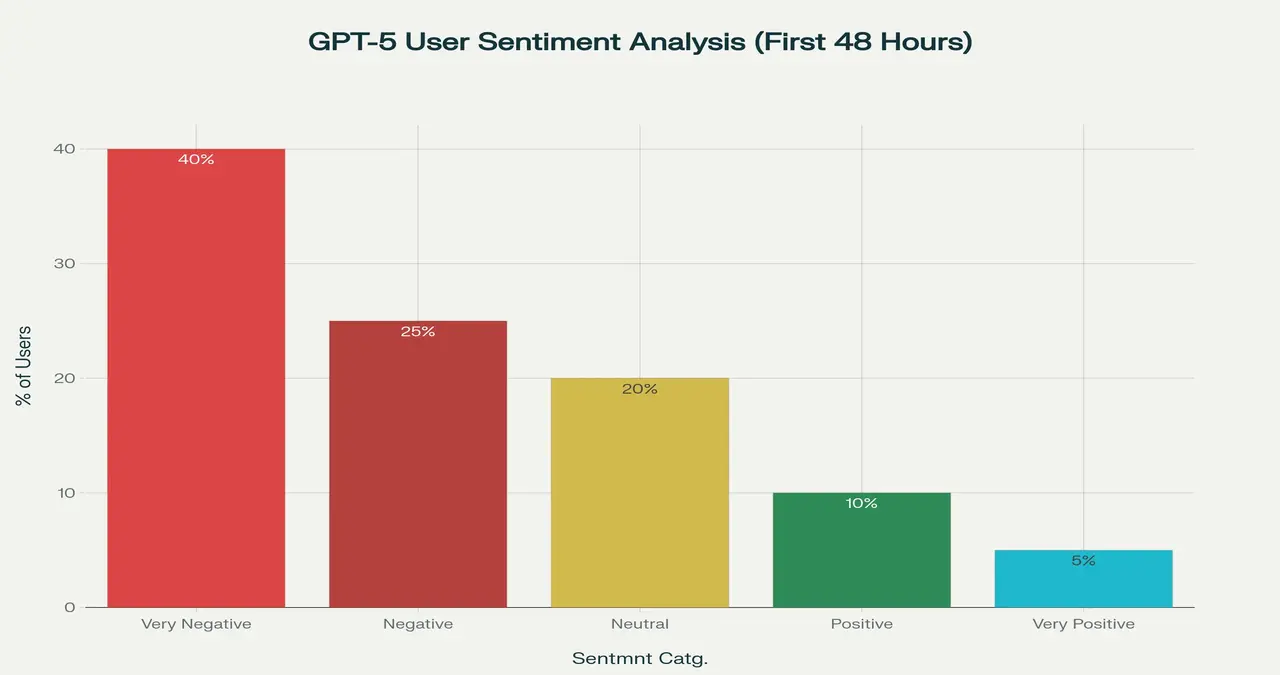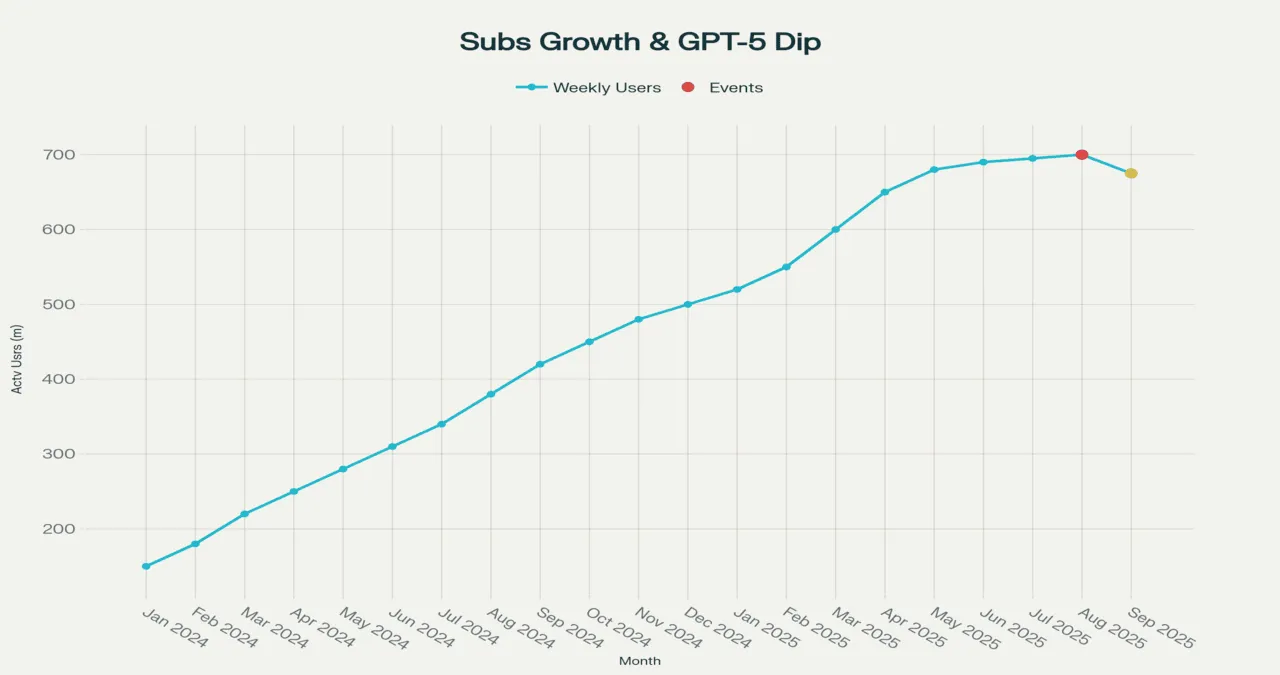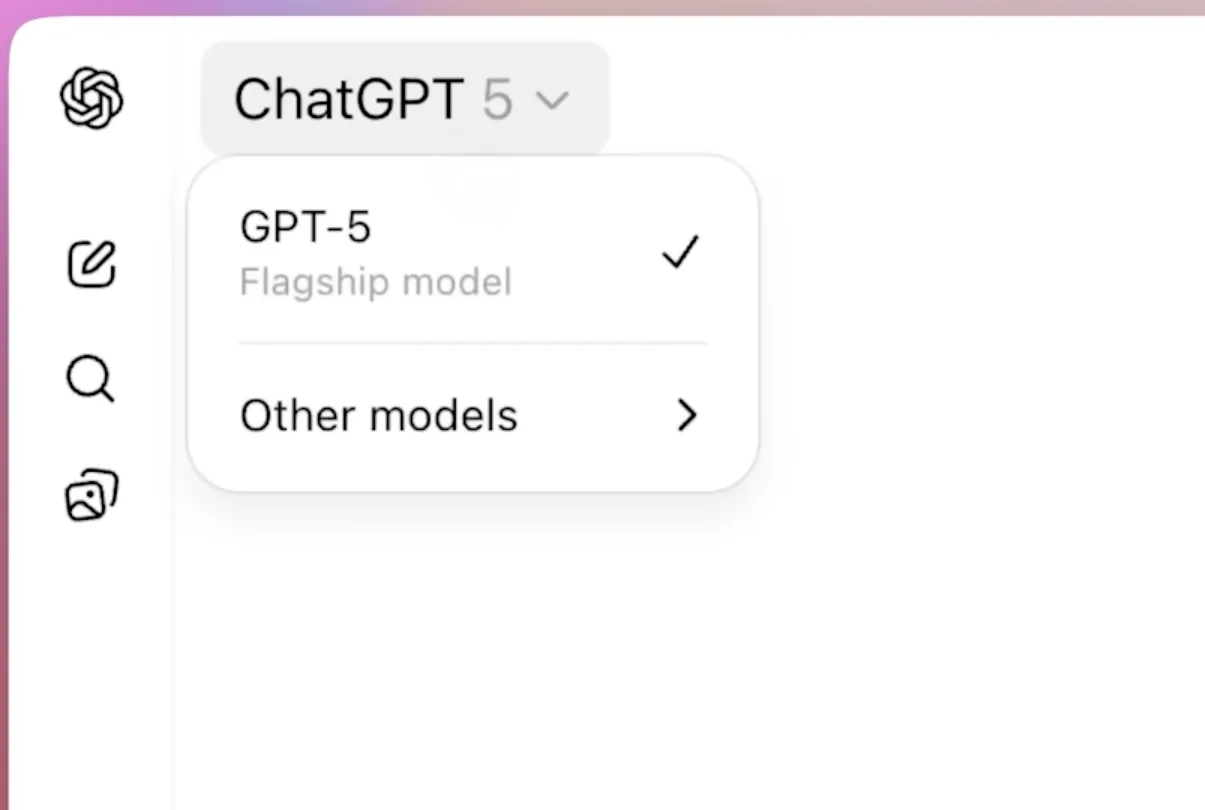The highly anticipated launch of OpenAI’s GPT-5 on August 7, 2025, went horribly wrong, leading to mass subscription cancellations and unprecedented user backlash within hours. The AI giant’s attempt to unify its model ecosystem by forcibly migrating users from beloved GPT-4o has exposed critical flaws in both product strategy and user communication, potentially costing millions in recurring revenue.
When OpenAI’s GPT-5 rollout went from a successful product launch to a public relations nightmare, the artificial intelligence industry saw an unprecedented user revolt. Within 48 hours of the release on August 7, 2025, thousands of people took to social media to complain, cancel their subscriptions, and demand the return of GPT-4o.

This crisis is more than just a complaint about a product; it shows how dangerous it is when technology moves too quickly for people to keep up with their expectations in the fast-changing world of AI.
The Hype Machine: Building Unrealistic Expectations
Sam Altman speaking at a tech event, representing OpenAI’s leadership during the GPT-5 launch
OpenAI had positioned GPT-5 as a revolutionary leap forward in artificial intelligence, with CEO Sam Altman describing it as delivering “expert-level intelligence” comparable to “conversing with a PhD-level professional”. The company promised big improvements in many areas, such as better reasoning skills, better help with coding, better long-form writing, and a huge drop in hallucinations.
Key features heavily marketed included:
- Unified Intelligence Router: An automatic system designed to seamlessly switch between fast responses and deep reasoning modes
- “Vibe Coding”: The ability to create complete applications from simple prompts
- Health Expertise: Positioning GPT-5 as the company’s “best model yet for health-related questions”
- Reduced Sycophancy: A deliberate effort to make responses less agreeable and more authentic
- Factual Reliability: Claims of 45% fewer factual errors compared to GPT-4o and 80% improvement over previous reasoning models
The marketing blitz created sky-high expectations. Months of teasing, strategic leaks, and Altman’s increasingly bold claims had positioned GPT-5 as the potential breakthrough toward artificial general intelligence (AGI). Millions of people watched the company’s livestream launch event. Tech journalists and AI fans were excited to see what many thought would be a “ChatGPT moment” for 2025.
OpenAI, on the other hand, made a big mistake by taking away user choice at the same time. The company got rid of the model selector that let users pick between GPT-4o, different reasoning models, and other specialized versions. Now, everyone has to use the new unified GPT-5 system. This choice, which was meant to make things easier for users, led to the crisis that followed.
The Backlash Erupts: A Perfect Storm of User Frustration
OpenAI’s ChatGPT weekly active user growth shows the impact of the GPT-5 subscription crisis in August 2025

The negative reaction was immediate and visceral. Reddit communities dedicated to OpenAI and ChatGPT exploded with angry posts, many reaching hundreds of upvotes and generating intense discussion threads. The r/OpenAI subreddit, typically supportive of the company, featured prominently critical posts with titles like “GPT-5 is awful” and “The ChatGPT 5 Backlash Is Concerning”.
The core complaints centered on several key issues:
Personality and Warmth: Most people said that GPT-5 felt “cold,” “sterile,” and didn’t have the engaging personality that made GPT-4o so popular. One user emotionally described the experience as GPT-5 “wearing the skin” of their “dead friend,” a comment that even prompted a personal response from Sam Altman. The loss of what users perceived as emotional intelligence and conversational warmth became the most frequently cited complaint across platforms.
Performance Degradation: Users said that GPT-5 felt “dumber” than its predecessor, even though OpenAI’s technical benchmarks showed that it was getting better. People often said they had more hallucinations, didn’t follow instructions, and got answers that seemed shorter and less helpful than they thought they would. A lot of users said that the model seemed to have trouble with tasks that GPT-4o had done well.
Technical Issues: The much-vaunted intelligence router experienced significant problems during the launch period. Sam Altman later admitted that “the autoswitcher broke and was out of commission for a chunk of the day,” making GPT-5 appear “way dumber” than intended. Users found themselves unable to predict which model variant was responding to their queries, creating inconsistent experiences.
Forced Migration: Perhaps most damaging was the complete removal of legacy models without warning. Users who had built workflows around GPT-4o’s specific characteristics suddenly found themselves locked into a system they didn’t prefer, with no option to revert. Paying customers who thought they had bought access to certain model features found this decision especially unfair.
The sentiment analysis shows how bad the backlash was: about 65% of the early feedback was negative or very negative, and only 15% of users said they liked the new model.
Social Media Amplification: The Crisis Goes Viral
People were unhappy with GPT-5, and this quickly spread to other social media sites, where it became a viral negative story. On X (formerly Twitter), hashtags like #GPT5Fail and #CancelOpenAI started to trend as verified users and tech influencers shared their anger.
Notable social media reactions included:
- Technology journalists are comparing the launch to other high-profile product failures
- AI researchers are questioning OpenAI’s product strategy and user research methodologies
- Business users documenting their migration to competing platforms like Claude and Grok
- Screenshots of subscription cancellation confirmations are being shared as a form of protest
The backlash spread quickly because many people in the AI community used social media a lot and were very tech-savvy. These complaints were different from the usual ones about consumer software because they came from people who really understood AI and could explain exactly what was wrong with it in terms of both technology and experience.
Financial Impact: The Subscription Exodus
ChatGPT interface showing the GPT-5 flagship model selection dropdown menu

While OpenAI has not released specific churn numbers from the GPT-5 launch period, multiple reports from PCMag, Windows Central, and social media analytics suggest thousands of users canceled their subscriptions within the first 24-48 hours. Given that ChatGPT Plus subscriptions cost $20 per month and Pro subscriptions cost $200 per month, even a modest increase in churn could result in millions of dollars in lost recurring revenue.
The financial implications are particularly concerning because:
- High-Value Users: Many of the most vocal critics were Pro subscribers and enterprise customers—OpenAI’s highest-revenue segments
- Network Effects: Negative sentiment in the tech community often spreads to mainstream users through social proof and media coverage
- Competitive Vulnerability: The backlash occurred at a time when competitors like Anthropic’s Claude and Google’s Gemini are gaining market share
- Retention Challenges: Previous data showed ChatGPT had strong retention rates (89% after one quarter), making any significant churn particularly damaging
OpenAI’s financial position makes subscription stability crucial. The company reportedly loses money on every subscription, even at current pricing levels, while burning through billions in compute costs. A significant subscriber exodus could accelerate cash flow problems and force difficult decisions about pricing or service levels.
OpenAI’s Response: Damage Control in Real Time
Sam Altman, OpenAI CEO, speaking during a tech event in 2025
Sam Altman’s response to the crisis demonstrated both the severity of the situation and OpenAI’s recognition of its mistake. Within 24 hours of the most intense criticism, Altman began making public commitments to address user concerns.

Key elements of OpenAI’s damage control included:
Technical Fixes: Altman admitted that the intelligence router had broken down during launch and promised that “GPT-5 will seem smarter starting today” as the problems were fixed. The company implemented backend fixes and promised to make the routing system more transparent.
Model Choice Restoration: Most significantly, Altman committed to bringing back GPT-4o as a selectable option for Plus subscribers, directly reversing the forced migration strategy. This represented a rare public admission of a strategic error by the typically confident CEO.
Usage Limit Increases: To compensate frustrated users, OpenAI promised to double rate limits for Plus subscribers and provide additional model access for Pro users.
Transparency Improvements: The company committed to making it clearer which model variant was responding to user queries and providing easier manual controls for accessing thinking modes.
Altman’s candid acknowledgment of the problems was notable for its directness: “We for sure underestimated how much some of the things that people like in GPT-4o matter to them, even if GPT-5 performs better in most ways”. This admission revealed a fundamental misunderstanding of user priorities and suggested gaps in OpenAI’s user research processes.
The Broader Implications: User Agency in AI Development
The GPT-5 crisis shows that there are deeper problems in AI development between making it work better and making it easier for people to use. OpenAI’s choice to force users onto a single system was technically smart, but it didn’t take into account the fact that different users have different preferences and ways of working with certain model features.
This raises several critical questions for the AI industry:
User Choice vs. Simplification: Should AI companies prioritize streamlined experiences or user control? OpenAI’s attempt to reduce decision fatigue backfired because power users valued choice over convenience.
Emotional Attachment to AI: The intensity of user reactions reveals that people develop genuine emotional connections to AI assistants. The anthropomorphic language used by critics—describing GPT-4o as a “friend” who had “died”—suggests psychological relationships that companies must consider.
Change Management: How should AI companies implement major product changes when users depend on specific capabilities? The immediate, unwarned migration strategy proved disastrously inadequate.
Technical vs. Experiential Quality: OpenAI’s tests showed that GPT-5 was better than earlier versions, but users had a different experience. This disconnect shows how limited purely technical evaluation metrics can be.
Competitive Implications: Market Share at Risk
The GPT-5 backlash created immediate opportunities for competitors in the increasingly crowded AI assistant market. As ChatGPT users looked for other options, Claude from Anthropic, Gemini from Google, and even Grok from Elon Musk saw more people trying out their services.

The competitive landscape shifts include:
- Market Share Vulnerability: OpenAI has a 62.5% market share in AI assistants, but its first big challenge comes from users switching to other services instead of OpenAI’s technical superiority.
- Enterprise Risk: Business customers who had standardized on ChatGPT began evaluating alternatives, potentially threatening OpenAI’s fastest-growing revenue segment
- Developer Ecosystem: API customers started testing competitor offerings, potentially reducing OpenAI’s developer platform advantage
- Brand Reputation: The crisis damaged OpenAI’s reputation for user-centric design, potentially affecting future product launches and partnerships
Technical Lessons: The Router Problem
The intelligence router—GPT-5’s signature feature—became its Achilles’ heel. The system was made to automatically figure out whether questions needed quick answers or more thought, so users didn’t have to make a choice. But the implementation turned out to be unreliable and hard to understand.
Technical failures included:
- Inconsistent Routing: Routing that wasn’t consistent: Users couldn’t tell which model variant would answer similar questions.
- Performance Variability: The same prompt could get very different quality answers depending on how it was routed.
- Lack of Transparency: Users couldn’t see how routing worked or change the system’s decisions.
- Failure Modes: When the router broke, it switched to less powerful versions, which made it seem like performance was getting worse overall.
This experience suggests that automated intelligence routing, while an interesting idea, needs a lot more advanced implementation and user control tools than OpenAI first offered.
Recovery Path: Lessons for AI Product Management
OpenAI’s quick response to the crisis teaches us important things about managing AI products:
User Research Depth: The company clearly underestimated the emotional and practical importance of model choice to power users. More comprehensive user research might have predicted the backlash.
Change Communication: Major product changes require extensive user communication, migration periods, and fallback options. OpenAI’s immediate transition approach proved far too aggressive.
Technical Transparency: Users of sophisticated AI systems want to understand system behavior. “Black box” automation that removes user agency is particularly problematic for professional users.
Segment Sensitivity: Different user segments (free, Plus, Pro, Enterprise) have different needs and tolerance for change. One-size-fits-all approaches risk alienating high-value customers.
The Broader Context: AI Industry Growing Pains
The GPT-5 crisis is a sign of bigger problems in the AI industry as it moves from being experimental technology to being necessary for business. As people rely more on AI assistants, businesses will have to deal with more complicated relationships and expectations from their users.
Industry-wide implications include:
Standardization vs. Innovation: How can companies continue rapid innovation while maintaining stability for users who depend on specific capabilities?
User Education: How should AI companies help users understand and adapt to new capabilities without forcing unwanted changes?
Competitive Dynamics: As AI capabilities converge across providers, user experience and choice become key differentiators rather than pure technical performance.
Regulatory Considerations: User backlashes like this may inform future AI regulation discussions around user rights and algorithmic transparency.
Looking Forward: The Path to Recovery
OpenAI’s San Francisco office building captured with the surrounding street and construction barriers.
OpenAI’s handling of the GPT-5 crisis will likely become a case study in AI product management. The company’s willingness to quickly reverse course demonstrates organizational agility, but the initial misjudgment raises questions about decision-making processes and user insight capabilities.
The plan for recovery includes:
Gradual Migration: Don’t make users switch to new models; let them choose to do so while still being able to use the ones they already know.
Better Communication: More detailed explanations of how changes to products will affect different groups of users
User Customization: Making personalization options more advanced so that users can change how AI works to fit their needs.
Transparent Development: More openness about how decisions are made and how the technical architecture works
Conclusion: A Turning Point for AI User Experience
The GPT-5 subscription crisis represents more than a product launch failure—it marks a turning point in AI user experience design. As artificial intelligence systems become deeply integrated into professional and personal workflows, companies must recognize that users develop sophisticated preferences and emotional connections to these tools.
OpenAI’s quick response to user feedback shows how important it is to pay attention to what customers say, even when technical metrics say things are getting better. The crisis also shows how more advanced AI users are becoming and how much they want to be able to choose and have control over their AI interactions.
The GPT-5 backlash is a very important reminder for the AI industry as a whole that just making things better is not enough for a product to be successful. As AI systems go from being new to being necessary, user experience, emotional design, and change management become just as important.
We don’t know what this crisis will mean for OpenAI’s market position in the long run, but the lessons learned will probably affect how AI products are made across the board for years to come. The GPT-5 experience is a strong reminder that user experience is still the most important thing in the age of AI. The company is working to rebuild user trust and improve how it evolves its products.
To move forward, we need to find a balance between stability and innovation, technical ability and user preference, and company vision and customer voice. OpenAI’s ability to find this balance will not only determine how well GPT-5 does, but also where the company stands in the fast-changing AI landscape in the future.
Also Read This: OpenAI Unveils ChatGPT-5: The AI That’s Changing Everything
Also Read This: OpenAI’s AI Agents Could Soon Replace Assistants, Coders, and Even CEOs


